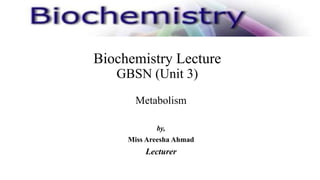GBSN - Biochemistry (Unit 3) Metabolism
•Télécharger en tant que PPTX, PDF•
0 j'aime•16 vues
Metabolism
Signaler
Partager
Signaler
Partager

Recommandé
Contenu connexe
Similaire à GBSN - Biochemistry (Unit 3) Metabolism
Similaire à GBSN - Biochemistry (Unit 3) Metabolism (20)
Bio 103 lecture 11_metbolism, enzymes, & respiration

Bio 103 lecture 11_metbolism, enzymes, & respiration
AP Biology Unit 8 Ecology Topic Two Energy Flow Through Systems

AP Biology Unit 8 Ecology Topic Two Energy Flow Through Systems
Therapeutic and diagnostic applications of enzymes isozymes and coenzymes

Therapeutic and diagnostic applications of enzymes isozymes and coenzymes
Energy flow in_the_cell_presentation_teacher_version

Energy flow in_the_cell_presentation_teacher_version
Plus de Areesha Ahmad
Plus de Areesha Ahmad (20)
GBSN - Microbiology Lab 1 (Microbiology Lab Safety Procedures)

GBSN - Microbiology Lab 1 (Microbiology Lab Safety Procedures)
GBSN - Biochemistry (Unit 4) Chemistry of Carbohydrates

GBSN - Biochemistry (Unit 4) Chemistry of Carbohydrates
GBSN - Biochemistry (Unit 7)Nucleic acid and nucleotide

GBSN - Biochemistry (Unit 7)Nucleic acid and nucleotide
GBSN - Microbiology (Unit 7) Microbiology in Everyday Life

GBSN - Microbiology (Unit 7) Microbiology in Everyday Life
GBSN - Microbiology (Unit 6) Human and Microbial interaction

GBSN - Microbiology (Unit 6) Human and Microbial interaction
GBSN - Biochemistry (Unit 2) Basic concept of organic chemistry 

GBSN - Biochemistry (Unit 2) Basic concept of organic chemistry
GBSN - Microbiology (Unit 3)Defense Mechanism of the body 

GBSN - Microbiology (Unit 3)Defense Mechanism of the body
GBSN - Biochemistry (Unit 1) Basic concept of Chemistry 

GBSN - Biochemistry (Unit 1) Basic concept of Chemistry
GBSN - Microbiology (Unit 2) Control of Microorganisms

GBSN - Microbiology (Unit 2) Control of Microorganisms
GBSN - Microbiology (Unit 1) Introduction to Microbiology

GBSN - Microbiology (Unit 1) Introduction to Microbiology
Dernier
Dernier (20)
Isolation of AMF by wet sieving and decantation method pptx

Isolation of AMF by wet sieving and decantation method pptx
WASP-69b’s Escaping Envelope Is Confined to a Tail Extending at Least 7 Rp

WASP-69b’s Escaping Envelope Is Confined to a Tail Extending at Least 7 Rp
Constraints on Neutrino Natal Kicks from Black-Hole Binary VFTS 243

Constraints on Neutrino Natal Kicks from Black-Hole Binary VFTS 243
Continuum emission from within the plunging region of black hole discs

Continuum emission from within the plunging region of black hole discs
The importance of continents, oceans and plate tectonics for the evolution of...

The importance of continents, oceans and plate tectonics for the evolution of...
Lec 1.b Totipotency and birth of tissue culture.ppt

Lec 1.b Totipotency and birth of tissue culture.ppt
mixotrophy in cyanobacteria: a dual nutritional strategy

mixotrophy in cyanobacteria: a dual nutritional strategy
A Giant Impact Origin for the First Subduction on Earth

A Giant Impact Origin for the First Subduction on Earth
NuGOweek 2024 full programme - hosted by Ghent University

NuGOweek 2024 full programme - hosted by Ghent University
Exomoons & Exorings with the Habitable Worlds Observatory I: On the Detection...

Exomoons & Exorings with the Habitable Worlds Observatory I: On the Detection...
National Biodiversity protection initiatives and Convention on Biological Di...

National Biodiversity protection initiatives and Convention on Biological Di...
B lymphocytes, Receptors, Maturation and Activation

B lymphocytes, Receptors, Maturation and Activation
Land use land cover change analysis and detection of its drivers using geospa...

Land use land cover change analysis and detection of its drivers using geospa...
Alternative method of dissolution in-vitro in-vivo correlation and dissolutio...

Alternative method of dissolution in-vitro in-vivo correlation and dissolutio...
GBSN - Biochemistry (Unit 3) Metabolism
- 1. Biochemistry Lecture GBSN (Unit 3) Metabolism by, Miss Areesha Ahmad Lecturer
- 4. Metabolism
- 15. • A metabolite is a substance that is created or used when the body breaks down food, drugs, chemicals, or its own tissue. • Metabolites are usually small molecules that act as intermediates or end products of metabolism
- 16. Endothermic means absorbing heat from its surroundings Exothermic means a process or reaction that releases energy usually in the form of heat
- 17. Nicotinamide adenine dinucleotide phosphate (NADPH) is a biological carrier of electrons that functions as a coenzyme in all living organisms
- 18. (Pyruvic acid) (Nicotinamide adenine dinucleotide) NADH is a coenzyme found in all living cells
- 23. Ketones are a type of chemical that your liver produces when it breaks down fats. Your body uses ketones for energy typically during fasting, long periods of exercise, or when you don't have as many carbohydrates
- 24. Assignment
